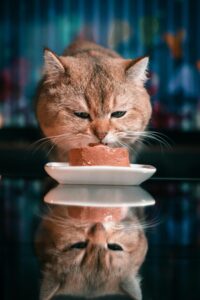Unlocking the Secrets of Cat Food Labels: A Detailed Guide for Responsible Pet Owners
Understanding how to read cat food labels might seem trivial at first, but it is vital for ensuring your cherished feline receives the necessary nutritional balance for optimal health and longevity. These labels provide critical insights that go far beyond the surface, serving as a comprehensive guide to the quality and ingredients of your cat’s diet. By learning to interpret these labels effectively, you can make educated choices that significantly enhance your cat’s overall well-being and lifespan, ensuring they live a happy, healthy life.
A key element of understanding cat food labels is the specific language employed. Phrases like “complete and balanced” indicate that the product meets the nutritional standards established by the Association of American Feed Control Officials (AAFCO). Familiarizing yourself with these definitions helps you select foods that provide the essential nutrients necessary for your cat’s well-being. This knowledge empowers you to make choices that cater to your feline’s unique dietary needs, ensuring they receive a balanced diet that supports their health and vitality.
As you analyze cat food packaging, terms such as ‘natural’ and ‘organic’ frequently appear. While these labels may initially attract consumers, they carry distinct meanings and implications regarding quality. The term ‘natural’ generally implies the absence of artificial flavors or colors, yet it does not guarantee superior quality. In contrast, ‘organic’ signifies adherence to specific farming practices that often result in a higher standard of safety and quality, making it a preferred choice for health-conscious pet owners who want the best for their feline companions.
The AAFCO plays a crucial role in setting the nutritional standards that govern the pet food industry. Their guidelines guarantee that products labeled as ‘complete and balanced’ have met specific dietary requirements tailored to various life stages of pets. Understanding these labels is essential for pet owners aiming to make informed decisions about their cat’s nutrition and health. By leveraging this understanding, you can confidently choose the most suitable options for your cat’s unique dietary needs and lifestyle.
Gaining a thorough understanding of the information on your cat’s food label can greatly enhance your ability to make nutritious decisions that foster their health and well-being. The insights you acquire will empower you to select premium-quality food that meets your cat’s specific dietary requirements and promotes a healthier, happier life.
 Essential Techniques for Analyzing Cat Food Ingredients
Essential Techniques for Analyzing Cat Food Ingredients
A fundamental aspect of understanding cat food labels is the meticulous examination of the ingredients list. Ingredients are typically listed by weight before cooking, meaning that the first few items represent the primary components of the food. This hierarchy is vital, as it provides significant insight into what your cat consumes daily, allowing you to assess the food’s overall quality and nutritional value.
For cats, classified as obligate carnivores, it is crucial that protein sources predominate the ingredient list. Look for specific protein sources such as chicken, beef, or salmon appearing at the top of the list, rather than vague terms like ‘meat meal’. This specificity indicates a higher quality and more nutritious diet that aligns with your cat’s natural dietary needs, ensuring they receive the essential amino acids necessary for their health.
It is also essential to identify and minimize certain additives and fillers in your cat’s diet. Ingredients such as corn, soy, and wheat gluten may enhance the food’s volume but contribute little to the nutritional benefits for cats. Instead, opt for products that incorporate whole grains and vegetables, which can serve as healthier substitutes and contribute positively to a well-rounded diet that supports your cat’s health.
Exercise caution regarding artificial preservatives commonly found in pet foods, such as BHA, BHT, and ethoxyquin. While these substances are often included to extend shelf life, they may not be the healthiest choices for your feline friend. Instead, choose foods that utilize natural preservatives like vitamin E (tocopherols) or vitamin C (ascorbyl palmitate) to maintain the quality and safety of their diet.
If you come across unfamiliar or lengthy ingredient names, take the initiative to research them. Being well-informed about what your cat consumes is the best approach to ensure you are making knowledgeable choices that actively support their health and overall well-being.
Evaluating Nutritional Content: Achieving the Ideal Dietary Balance for Your Cat
Understanding the Guaranteed Analysis section on cat food labels is essential for gaining insights into the nutrient content of the food. This section typically outlines the minimum or maximum percentages of crude protein, fat, fiber, and moisture. Ensuring the right balance of these nutrients is critical for maintaining your cat’s overall health and vitality throughout their life stages.
The protein content is a primary consideration when selecting cat food. Cats require high levels of protein to thrive, so it is vital to ensure that adequate amounts come from animal sources, which are rich in essential amino acids. Avoid foods that primarily rely on plant-based proteins, as these often lack the complete range of nutrients that cats require for optimal health and well-being.
Another significant factor to consider is the carbohydrate content. While some carbohydrates can be beneficial when included in moderation, they should not dominate the ingredient list, especially for cats that may be prone to weight gain. Aim for food options that prioritize higher protein levels and lower carbohydrate content, which supports a healthy, balanced diet tailored to your cat’s needs.
Essential nutrients, such as taurine, play a vital role in your cat’s health. Taurine is crucial for maintaining heart and eye health, and since cats cannot synthesize it on their own, it is imperative to ensure that your chosen food contains this essential amino acid. Always verify the label to confirm taurine is included, as it is a fundamental component for your cat’s well-being.
Be vigilant regarding potential allergic reactions in cats that may arise from specific food ingredients or imbalances in their diet. Common allergens can vary widely, so closely observe your pet to identify any adverse responses. If necessary, consider exploring hypoallergenic food options specifically designed for sensitive cats, ensuring their dietary needs are met without triggering allergies.
 Proven Strategies for Choosing the Best Cat Food for Your Furry Friend
Proven Strategies for Choosing the Best Cat Food for Your Furry Friend
Selecting the best food for your cat involves more than merely choosing the product with the most attractive packaging. It requires aligning the nutrition with your cat’s individual needs and lifestyle. When making your choice, consider critical factors such as your cat’s age, activity level, and any specific health concerns they may have, as these elements significantly influence their dietary requirements.
Customizing the diet to fit your cat’s lifestyle can profoundly impact their health and overall vitality. For instance, an active outdoor cat typically requires more calories and protein compared to a more sedentary indoor cat. Acknowledging their daily activities will help guide you in providing a diet that meets their specific energy demands and supports their health effectively.
Remember, price does not always equate to quality; therefore, it’s essential not to be swayed by cost alone. Sometimes, you may find yourself paying a premium for branding rather than actual nutritional benefits. Understanding what the ingredients and nutritional breakdown signify for your cat’s health is far more important than the price tag attached to the product.
Additionally, be aware that pet food brands often modify their recipes, sometimes subtly and other times significantly. Staying informed about these changes ensures that you are always aware of what is being served in your cat’s bowl. Regularly monitoring updates from brands can help you avoid unexpected dietary shifts that may adversely affect your cat’s health and well-being.
Finally, engaging with your veterinarian can provide personalized insights tailored to your cat’s specific health needs. A veterinarian can recommend appropriate foods that address dietary restrictions or health concerns, giving you peace of mind that your cat is receiving optimal nutrition for a fulfilling, healthy life.
The Article : How To Interpret Your Cat’s Food Labels Appeared First On Unity Pets.
The Article Interpreting Cat Food Labels: A Quick Guide Was Found On https://limitsofstrategy.com
Comments
2 responses to “Cat Food Labels Explained: A Quick Reference Guide”
I really appreciate this deep dive into cat food labels! It’s something that often gets overlooked, but as you mentioned, decoding that information is essential for our furry little companions’ health. I remember when I first brought my cat home; I was overwhelmed by the sheer number of options available at the local pet store. Honestly, I just picked the one with the most adorable packaging, thinking it wouldn’t matter much. It didn’t take long for me to realize that feeding her the right nutrition is so much more complex than that.
I completely relate to your experience with the overwhelming options at pet stores. It’s so easy to get drawn in by cute packaging or catchy marketing phrases. When I first adopted my cat, I made similar choices, leaning towards whatever looked appealing on the shelf. But once I started doing some research into what actually goes into cat food, it opened up a whole new world of information.